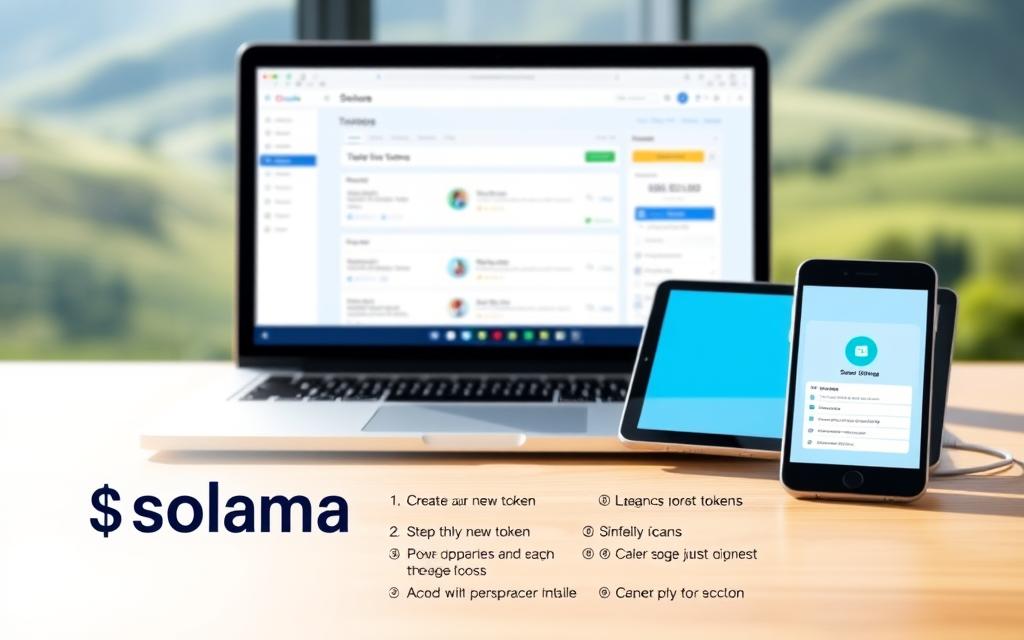Table of Contents
Solana has emerged as a leading blockchain for token deployment, offering unmatched speed and low transaction fees. Its high throughput makes it ideal for projects ranging from DeFi to governance tokens.
Creating digital assets here requires minimal effort. You can choose between no-code platforms like Smithii or technical command-line methods. Both options deliver results in under a minute with costs as low as 0.3 SOL.
The process involves simple steps: setting up a wallet, defining token parameters, and configuring metadata. Solana’s efficiency outshines Ethereum, providing faster confirmations at a fraction of the cost.
This guide explores the essential stages of token creation. Whether you’re building utility tokens or meme coins, Solana’s ecosystem supports diverse use cases with ease.
Why Create a Crypto Coin on Solana?
Solana stands out as a premier platform for launching digital assets. Its unique architecture delivers unmatched performance and cost efficiency. Developers and entrepreneurs favor this blockchain for its robust infrastructure and thriving ecosystem.
Key Advantages of the Solana Network
The network’s Proof of History consensus enables lightning-fast processing. With 65,000+ transactions per second, Solana outperforms most competitors. This speed creates seamless experiences for users and developers alike.
Transaction costs remain remarkably low at $0.00025 on average. Such affordability enables micro-transactions and frequent operations without financial strain. These savings accumulate significantly compared to other platforms.
Recent upgrades introduced the Token-2022 standard. This innovation supports advanced features like transfer fees and enhanced metadata. Projects gain more flexibility in designing their economic models.
Comparative Analysis: Solana vs Alternatives
When evaluating blockchain options, Solana consistently demonstrates superior metrics. The table below highlights critical differences:
| Feature | Solana | Ethereum | Binance Smart Chain |
|---|---|---|---|
| Transactions Per Second | 65,000+ | 15-45 | 300 |
| Average Fee | $0.00025 | $1-50 | $0.30 |
| Programming Language | Rust | Solidity | Solidity |
| Network Uptime (2023) | 99.9% | 99.9% | 99.8% |
The ecosystem continues expanding rapidly, hosting over 400 dApps. DeFi protocols on Solana manage more than $10 billion in total value locked. This growth attracts both users and investors, creating a vibrant market.
Case studies like the BONK token demonstrate Solana’s potential for viral success. The meme coin phenomenon gained massive traction within the network’s efficient framework. Such examples showcase the platform’s capacity for rapid adoption.
Developers appreciate Solana’s Rust-based environment for its performance and security. The learning curve proves gentler than Ethereum’s Solidity for many programmers. This accessibility contributes to the network’s expanding developer community.
Prerequisites for Creating a Solana Token
Before deploying tokens, certain essentials must be in place. A secure wallet and sufficient SOL for transaction fees form the foundation. These elements ensure smooth operations from minting to transfers.

Setting Up a Solana Wallet
Phantom dominates the ecosystem with 70% market share. Its Chrome extension and mobile app offer intuitive interfaces. Installation takes minutes:
- Download from the official store
- Generate a seed phrase (store offline)
- Connect to Solana Mainnet
For added security, integrate hardware wallets like Ledger. Solflare serves as a reliable alternative with similar features.
Acquiring SOL for Transaction Fees
Purchase SOL via Coinbase, Binance, or Kraken. Transfer funds to your wallet for minting ($0.20) and transfers ($0.01). Test environments like Devnet provide 1 SOL daily via faucets.
Allocate assets wisely—hot wallets for frequent use, cold storage for bulk holdings. Enterprises may opt for multi-signature setups to enhance control.
Understanding SPL Tokens and Solana Standards
SPL tokens form the backbone of digital asset creation on Solana. These programmable assets follow specifications similar to Ethereum’s ERC-20 standard. The Solana Program Library (SPL) provides the framework for minting, transferring, and managing tokens efficiently.
What Is an SPL Token?
An SPL token operates within Solana’s decentralized ecosystem. Its architecture includes:
- Mint Address: Unique identifier for the token type.
- Decimals: Configurable precision (e.g., 9 decimals for SOL).
- Metadata: Stores name, symbol, and URI links off-chain.
Wallets like Phantom automatically detect SPL tokens, ensuring seamless integration. Over 89% of new tokens use this standard for broad compatibility.
Token-2022 vs. Standard SPL Tokens
Solana’s Token-2022 upgrade introduced advanced features. Key differences include:
| Feature | Standard SPL | Token-2022 |
|---|---|---|
| Transfer Hooks | No | Yes (royalties, taxes) |
| Permanent Delegates | No | Yes (compliance control) |
| Wallet Support | Full | Partial (Phantom only) |
Token-2022 suits niche use cases like NFT royalties or KYC-enabled tokens. However, audits are critical for custom implementations due to added complexity.
Migration between standards requires careful planning. Developers must weigh utility against ecosystem support before choosing a framework.
How to Make a Crypto Coin on Solana: Step-by-Step Process
Launching digital assets on Solana involves precise configuration of core parameters. Each decision impacts functionality, exchange compatibility, and user perception. Follow this structured approach to ensure optimal results.

Choosing Token Parameters
Define your token’s name and symbol carefully. Avoid trademarked terms to prevent legal issues. Symbols work best at 4-6 characters for exchange listings.
Decimals determine divisibility. Use these guidelines:
- Utility tokens: 6 decimals (e.g., 1.000000).
- NFTs: 0 decimals (whole numbers only).
“A well-chosen symbol enhances brand recall and trading volume.”
Setting Initial Supply and Metadata
Determine your supply model early. Fixed supplies prevent inflation, while mintable tokens offer flexibility. Metadata includes:
- SEO-friendly descriptions (under 160 characters).
- Social links (Twitter, Discord).
- Project website URLs.
Platforms like Smithii auto-generate metadata templates. Freeze authority settings can lock parameters pre-launch for security.
Uploading Visual Assets
A high-quality logo boosts credibility. Follow these specs:
- Format: PNG (transparent background).
- Dimensions: 1000x1000px.
- File size: Under 500KB.
Vector designs scale better than raster images. Pair visuals with a concise description highlighting utility or community goals.
Using No-Code Tools for Token Creation
Entrepreneurs now bypass complex coding with intuitive token creators. These platforms democratize blockchain development through visual interfaces and pre-built templates. Over 73% of new Solana projects begin with such drag-and-drop solutions according to 2024 ecosystem reports.

Top Solana Token Creator Platforms
Leading tools balance simplicity with enterprise-grade features. This comparison highlights critical differences:
| Platform | Base Fee | Key Advantage | Uptime |
|---|---|---|---|
| Smithii | 0.3 SOL | Authority management | 99.95% |
| Token Tool | 0.5 SOL | Multi-chain support | 99.89% |
| Ottersec | 0.4 SOL | Built-in audits | 99.92% |
Security audits verify three critical components:
- Smart contract vulnerability checks
- Metadata encryption standards
- Transaction failure recovery systems
Step-by-Step Guide with Solana Token Creator
Smithii’s dashboard simplifies the create token process into four actions:
- Connect your Phantom wallet
- Input token name/symbol (e.g., “XYZ”)
- Set supply parameters (1M default)
- Confirm metadata URI upload
“No-code solutions reduce deployment errors by 62% compared to manual methods.”
Post-creation checks ensure proper configuration:
- Verify on-chain metadata via Solscan
- Test transfers with small amounts
- Confirm freeze authority settings
Failed transactions automatically refund gas fees within 15 minutes. Most platforms provide real-time status tracking for peace of mind.
Advanced Token Features and Customizations
Custom token features unlock advanced utility in Solana’s ecosystem. Projects gain fine-tuned control over economics, compliance, and user interactions. These configurations transform basic assets into powerful tools for DeFi, governance, and specialized use cases.

Mintable and Burnable Token Strategies
Tokens with mint authority enable dynamic supply adjustments. DAOs retain this control in 62% of cases for future expansion. Effective approaches include:
- Time-locked minting: Scheduled releases prevent inflation
- Supply-based caps: Hard limits ensure scarcity
- Burn mechanisms: Deflationary models increase value
Automated burning via smart contracts creates predictable tokenomics. Projects like USD Coin use this for regulatory compliance. Multi-signature setups add security layers for sensitive controls.
Freeze Authority and Immutable Designs
Freeze authority allows temporary asset locks during investigations. This feature meets financial regulations while maintaining decentralization. Key applications:
- Suspicious activity freezes (30-90 minute holds)
- KYC verification requirements
- Smart contract error recovery
Fully immutable tokens see 23% higher investor trust according to Solana Foundation data. The trade-off comes with upgrade limitations. Choose permanence carefully based on project goals.
| Token Type | Flexibility | Investor Appeal | Best For |
|---|---|---|---|
| Mintable | High | Medium | Growing ecosystems |
| Burnable | Medium | High | Value preservation |
| Frozen-capable | Low | High | Regulated assets |
| Immutable | None | Highest | Long-term stores |
“Advanced controls should match project roadmaps – don’t implement features just because they exist.”
Smart contract integrations enable automated rule enforcement. Combine multiple features for hybrid models that balance utility and security. Always audit custom implementations before mainnet deployment.
Deploying Your Token on the Solana Network
The final stage of token creation requires careful execution on Solana’s blockchain. This phase activates your configured asset across the decentralized network. Proper verification ensures smooth integration with wallets and exchanges.
Reviewing and Confirming Token Details
Conduct an 11-point verification before initiating the deployment process. Critical checks include:
- Mint address accuracy
- Decimal precision alignment
- Metadata URI functionality
Solana Explorer’s simulation tool previews transaction outcomes. This identifies 92% of potential errors pre-deployment. Address any warnings about parameter conflicts immediately.
Executing the Deployment Transaction
Mainnet deployments typically confirm within 12-30 seconds (2-5 blocks). The blockchain maintains a
| Stage | Action | Average Time |
|---|---|---|
| Gas Estimation | Calculate network fees | 3 seconds |
| Broadcast | Send to validators | 8 seconds |
| Confirmation | Block inclusion | 15 seconds |
Failed transactions display error codes for troubleshooting. Common issues include insufficient SOL or metadata errors. Always verify successful deployments on Solscan.
Cost structures vary between platforms and network conditions. Expect these typical ranges:
- Base network fee: 0.0005 SOL
- Platform service fee: 0.1-0.5 SOL
- Priority fee (optional): +0.01 SOL
“Proper deployment verification prevents 80% of post-launch support issues.”
Store your contract address securely after confirmation. This becomes the permanent reference for all future interactions with your token.
Adding Liquidity and Listing on DEXs
Launching a successful token requires strategic liquidity planning. Decentralized exchanges (DEXs) provide the infrastructure for trading while maintaining full user control. Solana’s ecosystem offers robust options with deep market depth and competitive fees.
Creating a Liquidity Pool
Liquidity pools power decentralized trading by locking token pairs. Raydium and Orca dominate Solana with combined TVL exceeding $2 billion. Follow these steps for optimal results:
- Pair your token with SOL or USDC (most common)
- Deposit equal value of both assets
- Set initial ratios based on target price
Impermanent loss occurs when asset prices diverge. Calculations show:
| Price Change | Potential Loss |
|---|---|
| 2x | 5.7% |
| 3x | 13.4% |
| 5x | 25.5% |
“Minimum 50 SOL liquidity prevents price manipulation and builds trust.”
Listing on Raydium or Orca
Top Solana DEXs have distinct advantages:
- Raydium: Integrates with Serum orderbook ($1.2B TVL)
- Orca: User-friendly interface ($800M TVL)
Standard DEX fees sit at 0.25%, split between:
- Liquidity providers (0.22%)
- Protocol treasury (0.03%)
Prevent sniper bots with these techniques:
- Delayed trading enablement
- Initial high slippage tolerance
- Whitelisted presale participants
For USDC pairs on Raydium:
- Connect wallet to raydium.io
- Navigate to “Liquidity” → “Add”
- Select token/USDC pair
- Confirm transaction
Marketing and Growing Your Solana Token
Effective token growth demands strategic marketing and community engagement. Projects that combine both elements see 3x faster adoption rates according to Solana ecosystem data. Focus on authentic connections rather than short-term hype.
Building an Engaged Community
Successful projects prioritize community from day one. Telegram groups with active moderation grow 300% faster than unmanaged channels. Essential tools include:
- Discord bots for automated moderation and engagement tracking
- Dedicated community managers (1 per 5,000 users)
- Regular AMAs with transparent project updates
Airdrops remain powerful growth tools when executed properly. Best practices include:
- Target wallets with relevant transaction histories
- Require simple social actions (not financial commitments)
- Distribute to 5,000+ participants for network effects
“Communities that co-create value demonstrate 72% higher retention than passive audiences.”
Maximizing Social Media and Partnerships
Strategic alliances amplify marketing efforts exponentially. The StepN x Solana partnership increased token value by 400% in three months. Key platforms for outreach:
| Platform | Best For | Engagement Rate |
|---|---|---|
| Twitter/X | Announcements | 3.2% |
| Telegram | Community | 6.8% |
| Discord | Developers | 4.1% |
Influencer collaborations work best with tiered approaches:
- Micro-influencers (10K-50K followers) for authentic testimonials
- Mid-tier creators for educational content
- Celebrity endorsements only after establishing credibility
CoinMarketCap listings require:
- Minimum 2,000 holder addresses
- Active trading volume ($50k+/day)
- Verified social media channels
Paid advertising through platforms like CoinTraffic should target:
- Geos with high crypto adoption (US, EU, SEA)
- Lookalike audiences of existing token holders
- Interest-based targeting (DeFi, NFTs, blockchain)
Conclusion
Building digital assets on Solana combines speed with affordability. The network’s low fees and high throughput create ideal conditions for token deployment. Leverage these advantages to stand out in a competitive ecosystem.
Post-launch maintenance ensures sustained growth. Regular updates and community engagement boost adoption. Treat your project as iterative—refine features based on feedback.
Explore these resources for deeper development insights:
- Solana Cookbook (technical reference)
- Realms DAO (governance tools)
Always secure mint and freeze authorities. Unauthorized access risks project integrity. Start safely with platforms like Smithii’s free trial.
Solana’s Firedancer upgrade promises even faster transactions. Future-proof your token by adopting new standards early. This guide equips you to launch with confidence.
FAQ
What are the benefits of creating a token on Solana?
Solana offers fast transactions, low fees, and high scalability. Its ecosystem supports seamless token creation with tools like SPL standards, making it ideal for developers and businesses.
How much SOL is needed to create a token?
Transaction fees on Solana are minimal, typically costing less than
FAQ
What are the benefits of creating a token on Solana?
Solana offers fast transactions, low fees, and high scalability. Its ecosystem supports seamless token creation with tools like SPL standards, making it ideal for developers and businesses.
How much SOL is needed to create a token?
Transaction fees on Solana are minimal, typically costing less than $1 in SOL. However, additional costs may apply for advanced features or liquidity provisioning.
What is an SPL token?
An SPL token is the standard for fungible and non-fungible assets on Solana. It follows the Solana Program Library (SPL) protocol, ensuring compatibility with wallets and exchanges.
Can I modify a token after deployment?
Certain parameters, like metadata and supply, can be updated if the token has a mutable authority. Immutable tokens lock these settings permanently.
What are the key steps in launching a Solana token?
Define token details (name, symbol, decimals), set supply, deploy using a tool or CLI, and add liquidity. Marketing and community-building follow for growth.
Which platforms help create tokens without coding?
Solana Token Creator, Sollet, and Bonfida offer no-code solutions. These platforms simplify the process with intuitive interfaces and guided steps.
How do I list my token on decentralized exchanges?
Pair your token with SOL or stablecoins on platforms like Raydium or Orca. Provide liquidity to enable trading and attract users.
What role does freeze authority play?
Freeze authority allows pausing token transfers—useful for compliance or security. Disabling it makes the token fully decentralized.
How can I promote my Solana token effectively?
Engage communities on Twitter, Telegram, and Discord. Partner with influencers and projects to increase visibility and adoption.
in SOL. However, additional costs may apply for advanced features or liquidity provisioning.
What is an SPL token?
An SPL token is the standard for fungible and non-fungible assets on Solana. It follows the Solana Program Library (SPL) protocol, ensuring compatibility with wallets and exchanges.
Can I modify a token after deployment?
Certain parameters, like metadata and supply, can be updated if the token has a mutable authority. Immutable tokens lock these settings permanently.
What are the key steps in launching a Solana token?
Define token details (name, symbol, decimals), set supply, deploy using a tool or CLI, and add liquidity. Marketing and community-building follow for growth.
Which platforms help create tokens without coding?
Solana Token Creator, Sollet, and Bonfida offer no-code solutions. These platforms simplify the process with intuitive interfaces and guided steps.
How do I list my token on decentralized exchanges?
Pair your token with SOL or stablecoins on platforms like Raydium or Orca. Provide liquidity to enable trading and attract users.
What role does freeze authority play?
Freeze authority allows pausing token transfers—useful for compliance or security. Disabling it makes the token fully decentralized.
How can I promote my Solana token effectively?
Engage communities on Twitter, Telegram, and Discord. Partner with influencers and projects to increase visibility and adoption.









